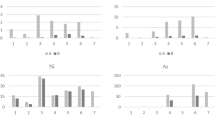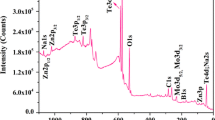Summary
Instrumental neutron-activation analysis was used for the determination of Ca, Cr, Fe, Co, Ni, Zn, Mo, Ag, Sb, and Hg. Blood and tissue samples of 70 mg each were analysed and, from these, changes in the concentrations of calcium, iron, and zinc in affected tissue were established. In this article the results of the behaviour of calcium and iron are reported. The calcium concentration of the fracture haematoma blood (FHB) is about 20 times higher than that of arterial or venous blood (rabbits). The level and the change with time of the calcium concentration in FHB-deposits (rabbits) can be explained by the participation of calcium in the haemolysis of the erythrocytes of the FHB which has been injected for the formation of the deposits. The behaviour of the iron in the FHB-deposits is in agreement with this explanation. The change in calcium concentration in the crust of punch-hole wounds in the skin (rats) can be attributed to the mobilization of calcium for fibrin formation. As a reason for the level and the change with time of the iron concentration in the tissue in the area of fascia and muscle incision wounds (rabbits) the participation of iron in the formation of collagen is discussed. From comparison of the behavoiur of the iron in the FHB-deposits with that in the area of incision wounds it follows that iron enrichments in the area of a complication-free wound are not predominantly caused by a wound haematoma.
Zusammenfassung
Die Untersuchungen erfolgten mit Hilfe der instrumentellen Neutronenaktivierungsanalyse. Das Verfahren war für die Erfassung der Gehalte an Ca, Cr, Fe, Co, Ni, Zn, Mo, Ag, Sb und Hg ausgelegt. Es wurden Blut bzw. Gewebeproben von jeweils etwa 70 mg analysiert und dabei Änderungen der Calcium-, Eisen- und Zinkgehalte des betroffenen Gewebes festgestellt. In diesem Artikel wird über das Verhalten des Calciums und Eisens berichtet. Der Calciumgehalt des Frakturhämatombluts (FHB) ist etwa 20mal höher als der von arteriellem oder venösem Blut (Kaninchen). Höhe und zeitlicher Verlauf der Calciumgehalte von FHB-Depots (Kaninchen) lassen sich mit der Beteiligung des Calciums an der Hämolyse der Erythrozyten des FHB erklären, das zur Bildung der Depots injiziert wurde. Das Verhalten des Eisens in den FHB-Depots stimmt mit dieser Erklärung überein. Der Verlauf der Calciumgehalte des Schorfes von Hautstanzwunden (Ratten) kann auf die Mobilisierung von Calcium für die Fibrinbildung zurückgeführt werden. Als Ursache für Höhe und zeitlichen Verlauf der Eisengehalte des Gewebes im Bereich von Faszie- und Muskelschnittwunden (Kaninchen) wird die Beteiligung des Eisens an der Kollagenbildung diskutiert. Aus dem Vergleich des Verhaltens des Eisens in FHB-Depots und im Bereich von Schnittwunden folgt, daß die Eisenanreicherungen im Bereich einer komplikationslosen Schnittwunde nicht vorwiegend durch ein Wundhämatom bedingt sind.
Similar content being viewed by others
References
F. Lux and R. Zeisler, Z. analyt. Chem.261, 314 (1972).
J. Schuster, F. Lux, and R. Zeisler, Mschr. Unfallheilkunde76, 537 (1973).
F. Lux and R. Zeisler, J. Radioanalyt. Chem.19, 289 (1974).
F. Lux, R. Zeisler, and J. Schuster, Langenbecks Arch. Chir.337, 615 (1974).
F. Lux, R. Zeisler, and J. Schuster, Trans. Am. Nuclear Soc.21, Supplement 3, 1 (1975).
F. Lux, J. Schuster, and R. Zeisler, J. Radioanalyt. Chem.32, 229 (1976).
Trace Elements in Human Health and Disease (eds.: A. S. Prasad and D. Oberleas), Vol. I. New York: Academic Press. 1976.
E. L. Lichti, J. A. Schilling, and H. M. Shurley, Am. J. Surg.123, 253 (1972).
M. Chvapil, J. Hurych, and E. Ehrlichova, Exp. Med. Surg.26, 52 (1968).
J. W. Bains, D. T. Crawford, and A. S. Ketchem, Ann. Surg.164, 243 (1966).
G. Kent, F. I. Volini, O. T. Minick, E. Orfei, and J. Huerga, Am. J. Pathol.45, 129 (1964).
D. J. Prockop and K. Juva, Proc. Natl. Acad. Sci. U. S. A.53, 661 (1965).
B. Peterkofsky and S. Undenfriend, J. Biol. Chem.238, 3966 (1963).
R. M. Donati, E. A. Levri, and Law. R. Stromberg, Proc. Soc. Exp. Biol. Med.139, 367 (1972).
E. L. Lichti, M. Turner, and J. H. Henzel, in Trace Substances in Environmental Health, IV (ed. D. Hemphill). Columbia: University of Missouri Press. 1971.
G. Blümel, Acta Chir. Austr.4, 122 (1970).
To be published. See also D. Božanić, Dissertation, Technische Universität München 1977.
H. Immich, Medizinische Statistik. Stuttgart: F. K, Schattauer Verlag. 1974. p. 216.
L. Sachs, Angewandte Statistik, Berlin: Springer-Verlag. 1974. p. 386
R. C. Campbell, Statistische Methoden für Biologie und Medizin, Stuttgart: G. Thieme. 1971. p. 68.
F. L. Siegel, Structure and Bonding, Vol. 17. Berlin: Springer-Verlag. 1973. p. 243.
S. M. Rapoport, Medizinische Biochemie. Berlin: VEB Verlag Volk und Gesundheit. 1973. p. 822.
H. J. Hernandez-Richter and H. Struck, Die Wundheilung. Stuttgart: G. Thieme. 1970.
G. Hegemann, Lehrbuch der Chirurgie (eds. H. Hellner, R. Nissen, and K. Vossschulte), Stuttgart: G. Thieme. 1970. p. 4.
p. 686 in Ref. 22.
p. 690 in Ref. 22.
B. R. Olsen, R. A. Berg, K. I. Kivirikko, and D. J. Prockop, Eur. J. Biochem.35, 135 (1973).
Author information
Authors and Affiliations
Rights and permissions
About this article
Cite this article
Lux, F., Božanić, D., Blümel, G. et al. Activation-analysis investigation of the behaviour of biological trace elements during wound healing: The roles of calcium and iron. Mikrochim Acta 69, 35–54 (1978). https://doi.org/10.1007/BF01196979
Received:
Issue Date:
DOI: https://doi.org/10.1007/BF01196979




